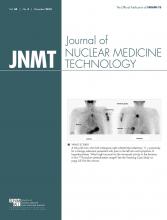Abstract
We present a case study of a 56-y-old man who was admitted with acute abdominal pain and was found to have retroperitoneal hematoma from a ruptured duodenal aneurysm. 99mTc-diisopropyliminodiacetic acid cholescintigraphy showed incidental absent transit of radiotracer into the distal duodenum and severe enterogastric reflux, thought to be secondary to duodenal obstruction from the hematoma. Findings were confirmed on esophagogastroduodenoscopy, and the patient improved after subsequent gastrojejunostomy.
Nuclear imaging using oral radiopharmaceuticals can also be useful for imaging intestinal transit (1). In this case, we present cholescintigraphy as an alternative intravenous method of imaging the small bowel tract (2).
CASE REPORT
A 56-y-old Caucasian man, with no prior surgical history, was admitted to the hospital for persistent upper abdominal pain associated with anorexia and nausea of 1-wk duration. There was mild right upper quadrant tenderness to palpation on examination and no laboratory abnormalities. A contrast-enhanced abdominopelvic CT demonstrated a retroperitoneal fluid collection adjacent to the duodenum, from a suspected rupture of duodenal gastroduodenal artery (Fig. 1). Because of persistent abdominal pain, there was concern for gallbladder pathology, prompting cholescintigraphy.
Sagittal (A), coronal (B), and transverse (C) CT images showing mixed soft-tissue density (arrows) consistent with hematoma, having mass effect on second portion of duodenum.
After intravenous administration of 188.7 MBq (5.1 mCi) of 99mTc-diisopropyliminodiacetic acid, images were acquired at 5-min intervals up to 60 min with a delayed image at 4 h (Fig. 2). The gallbladder was not visualized up to 4 h, indicating acute cholecystitis. An incidental finding of stasis of radiotracer in the proximal small bowel and significant progressive backflow of radiotracer into the stomach suggested a severe proximal duodenal obstruction.
Cholescintigraphy at 5 min (A), 30 min (B), 60 min (C), and 4 h (D). Gastric outlet obstruction was seen at 30 min, and enterogastric reflux was seen at 60 min and 4 h (arrows). Nonvisualization of gallbladder was consistent with acute cholecystitis.
Esophagogastroduodenoscopy confirmed a narrow stricture at the second portion of the duodenum (Fig. 3). Correlation with CT showed the retroperitoneal hematoma had mass effect on the second portion of the duodenum. The patient underwent a gastrojejunostomy, which relieved his symptoms.
Esophagogastroduodenoscopy demonstrating narrow stricture (arrows) at second part of duodenum, with no Doppler flow consistent with hematoma.
DISCUSSION
Diagnosis of various other primary intestinal pathologies have been previously described using cholescintigraphy (3). In this case, not only was there a diagnosis of acute cholecystitis, but also there was a diagnosis of gastric outlet obstruction. This was an unexpected incidental finding of bowel obstruction on cholescintigraphy secondary to hematoma from ruptured gastroduodenal artery and may have been an additional cause of the patient’s symptoms.
Because of negative ultrasound and CT results, gallstone ileus was ruled out (4). Mesenteric ischemia or adhesions from prior surgery were also excluded from the differential because of negative CT findings and negative surgical history.
CONCLUSION
This case presents the potential utility of cholescintigraphy in detecting obstructions distal to the duodenal papilla. This method may be easier for the patient than the alternative orally administered agents. Although not performed in this case, SPECT/CT can also improve the accuracy of detecting more distal small bowel obstructions.
DISCLOSURE
No potential conflict of interest relevant to this article was reported.
Footnotes
Published online Nov. 10, 2016.
REFERENCES
- Received for publication September 8, 2016.
- Accepted for publication October 26, 2016.










